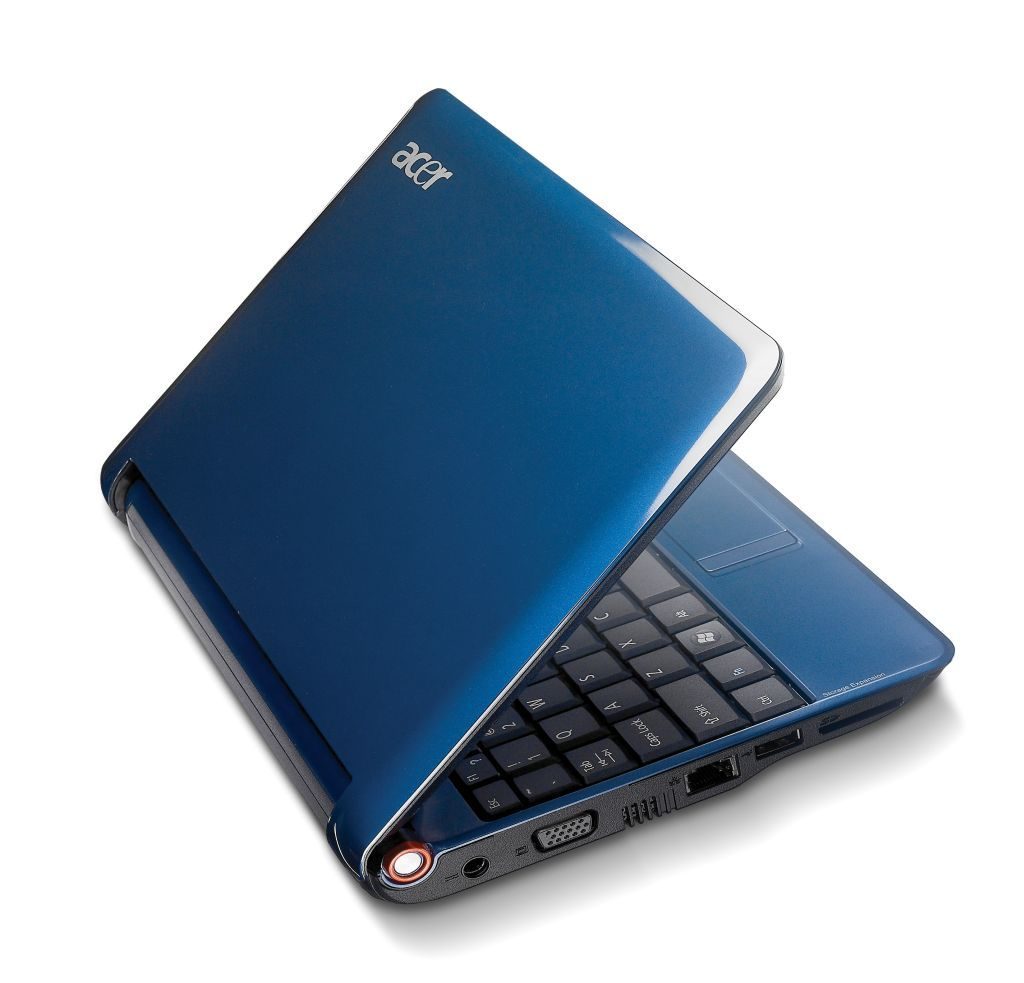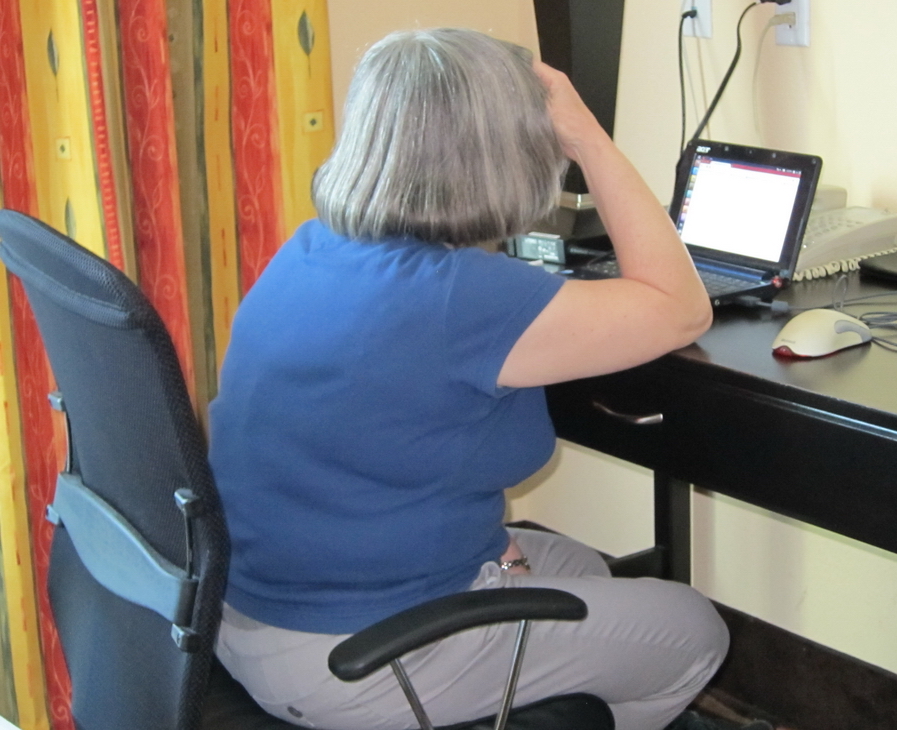
The netbook (2007-2012) can probably trace its origins back to the Toshiba Libretto of the late 1990s but it was heavily influenced by the One Laptop Per Child project of the early 21st century. OLPC – a largely academic project – had the goal of making a cheap and rugged small laptop for distribution in the third world. The computer makers ASUS and Acer took the OLPC concept a bit further and by 2007 had come up with the first generation of netbooks. The basic netbook design had the following features:
- Low power processor (Intel Atom 32 bit)
- Onboard graphics to match the processor capability
- No heavy extras like an optical drive
- Low capacity solid state drive (enough for the operating system and some basic programs)
- Wifi connected
- Relatively low power consumption
- Smaller and low resolution display
- Smaller keyboard layout
- Low RAM capacity with some RAM chips right on the motherboard
These were made by a variety of manufacturers.
The netbook – at least the OLPC version – was born to run Linux, and it can’t be denied that Linux should have powered all the early netbooks. Linux can work well with limited hardware resources and doesn’t have to run CPU sucking security programs.
The very first netbooks were in fact Linux machines but the makers dropped the ball when it came to installation of an alternate operating system. At the time Windows XP was the default personal computer O/S, and just about every PC user wanted a Windows look and feel when they switched on a PC. Instead the makers went with dumbed down versions of Linux that looked nothing like Windows. It was possible to dump these crummy Linux versions and get a real Windows like desktop, but you had to be a bit of a geek to do it. 99% of the initial netbook users didn’t want to do this. They hated Linux, returned the machines in droves and the manufacturers soon learned that in order to sell the puny laptops, they would have to offer them with Windows.
Microsoft – who had watched the introduction of Linux machines with dismay – was anxious to oblige. Unfortunately, their flagship O/S by this time was Vista – and Vista was too much of a resource hog to ever run well on a netbook. Microsoft was forced to bring the obsolete XP back from the dead and offer it to the manufacturer essentially for free. The makers had to replace the small SSD with a larger mechanical hard drive to accommodate the bulkier Microsoft programs and security apps.
The net result killed Linux on netbooks. That was to be expected. However the new Windows based netbook was a technical disaster and a marketing nightmare. Most consumers did not see the netbook as a low cost way to get on the Internet. They assumed it was just a cheap general purpose Windows PC. With low processing power, low memory, a slow mechanical drive and Windows XP the netbook was a total pig when it came to startup and operation. A lot of them were sold, but very few customers were satisfied.
There wasn’t much profitability for the makers either. Even with the benefit of an practically “free” Windows operating system, the margins on netbooks were low and the competition was fierce. This was the netbook market in 2008 and 2009.

Here’s a netbook hard at work in Fort Lauderdale. It was perfect to stick in a backpack and use in a hotel to catch up on your email. Still is.
By 2010 the netbook market was getting mature and technology had improved. The second generation of Intel Atom processors came out – these supported 64 bit operation – and AMD was getting into the act with its “Athlon Neo” line of mini-processors. Graphics were integrated more tightly with the CPU, power consumption was reduced and battery life increased. There was still a problem with profitability and performance – especially when Microsoft no longer offered Windows XP to netbook makers.
By 2010 Microsoft had moved on to Windows 7 and they were in no mood to give it away – not that it would have worked all that great on a netbook. Instead Microsoft sold the netbook makers a brain-dead “Windows 7 Starter” operating system and made sure that it went on machines that were so memory challenged that anyone who got such a unit would be unhappy. You could buy a netbook and increase its RAM yourself – but how many did? The reputation of netbooks as operational pigs continued – and was richly deserved by now.
Nevertheless 2010 probably marked the zenith for the humble netbook – technically and commercially. From there it was all downhill, until by the end of 2012 there was not one manufacturer making them at all. Two major things contributed to the sickening and decline of the netnook.
- Folks who really wanted a general purpose small computer realized that you get what you pay for. They gravitated to Macbook Air or Ultrabook laptops, which featured more powerful hardware that was capable of running Windows 7 itself – not a stripped down version. These units cost more but in my view were worth it.
- Folks who just wanted a cheap and lightweight unit to get on the Internet moved to that consummate netbook killer – the tablet. Whether it was an iPad or one of the Android variants, tablet computing totally displaced the cheap and cheerful netbook at the lower end of the market.
So what of the netbook today? Are any of the original units still around? Well yes. If you’re smart enough to dump Windows and use a netbook the way it was meant to be used, there’s still some life in the old beasts.
I have three of them now – two are older first generation 32 bit machines that are becoming museum pieces. Their operating systems are losing support, and they are slow and outdated even with a lightweight Linux distribution installed. They won’t run HD videos, and as for any type of game – fuggedaboudit. Web browsing today is becoming increasingly memory intensive and the older machines need a very lightweight browser to work well. They would be OK for writing and note taking I suppose. I have upgraded them as much as I can and I use them as testing machines for Linux that is designed for older hardware.
My third machine – which I rescued recently from a trip to the recycler – is a different proposition. It has a 2nd generation Atom processor and graphics, supports 64 bit operation and best of all you can replace its standard laptop hard drive with an inexpensive solid state drive. The SSD makes a huge difference in responsiveness. Although this machine is still a bit low on memory capacity it will do a good job as a travel machine where all you want it for is email and light web surfing. It cost next to nothing and it’s quite rugged with its new hard drive so I can pack it and tote it and not worry about theft or breakage. It’s one of those unfortunate machines that ran like a dog on Windows but is pretty good with Manjaro Linux or some other lightweight operating system.
One final point. The netbook which appeared to be dead as a doornail in 2012 is now back alive in a couple of ways. Tablets that feature detachable keyboards, or the Chromebook pioneered by Google are really netbooks redux – lower powered units for getting on the Internet to do stuff. Linux has even made a comeback as either Android (on tablets) or Chrome O/S (on Chromebooks.)
So there you have it. What was once dead lives on in a new form or through modification to what it should have been in the first place. Not a bad Easter tech story.